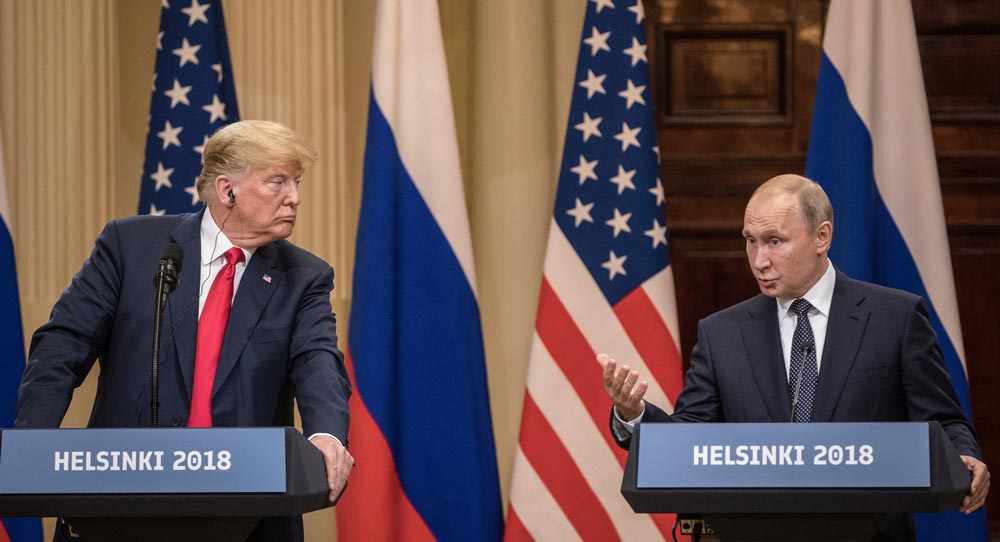The best thing about the July 16 meeting between U.S. President Donald Trump and Russian President Vladimir Putin is that it—and the frenzy that accompanied it—is finally over. On a certain level, one is tempted to ask what all the fuss was about. The presidents’ statements at the eagerly awaited press conference were expected to be general in nature and not veer from their well-known domestic and foreign policy positions. However, the worldwide focus on every word and gesture at this meeting painfully underlined that the style of world politics has changed and that Western governments, including parts of the U.S. bureaucracy, are struggling to find a suitable response. Overall, the signal sent by the summit that wasn’t called a summit is deeply worrying for the EU and NATO, as well as for the populations in Western democracies who see that a value- and rules-based international order can no longer be taken for granted.
Any loose statements Trump might have made during his two-hour private meeting with Putin may never be known or verified. Contrary to widespread fears among Western observers and Trump’s own statements in the run-up to the meeting, details regarding Russia’s annexation of Crimea and the Western sanctions were conspicuously absent from the carefully crafted statements at the press conference. When answering journalists’ questions, it was interestingly Putin who chose to address the Crimea issue. He explicitly stated that the United States considered the border change to be illegal, whereas Russia saw the matter differently. He referred to “we” when mentioning holding a “democratic” referendum in Crimea. To date, the emphasis in the official Russian narrative had been on Russia responding to the demands of the Crimean population rather than orchestrating the events in February and March 2014.President Trump tried to frame the meeting as the latest in a long series of historic American-Soviet and American-Russian summits, several of them held in Helsinki. Neither the context nor the (missing) substance of the meeting merits this comparison. At best, the meeting could be the starting point for stepping up dormant contacts at different levels of the military, security, and political structures on both sides. One related hope had been that this meeting could reinvigorate a joint commitment to nuclear disarmament. While President Trump emphasized this at least in general terms by referring to the overarching objectives of peace and stability, President Putin kept silent on the issue.
Both presidents primarily spoke to their domestic audiences. Putin still derives a significant part of his legitimacy at home from his foreign policy, which helps to distract from internal socioeconomic problems. Trump appealed to his supporters by reassuring them of his America First approach. Similarly, Putin emphasized in the Q&A part of the press conference that both countries put their national interests first and that trust in each other was low.
The commonalities in the two presidents’ approaches are striking: both show contempt for the rule of law and the freedom of the press; they jump on opportunities to showcase the structural weaknesses of the EU and NATO; and when Trump called the EU, China, and Russia “foes” in the run-up to the meeting, his rhetoric resembled the image of a beleaguered fortress that Putin has painted of Russia for a long time.
A considerable amount of time at the press conference was taken up by the issue of Russia’s interference in the U.S. elections. After a controlled opening in Trump’s statement that referred to having discussed the issue with Putin and inviting him to comment, Trump quickly lost himself in one of his trademark tirades against the Democrats and former presidential administrations—and once again questioned the evidence presented by the investigations so far. Putin could just lean back and watch as his counterpart was entangling himself in his arguments. When he referred to Putin’s “generous offer” to have U.S. investigators question Russian suspects in Russia, without mentioning Putin’s condition of reciprocal access to individuals such as Bill Browder, Trump looked embarrassingly out of his depth.
Putin had gone into the meeting from a position of strength. The setting provided him with the gratifying opportunity to present himself as an equal partner on the international stage, something he had aspired to for years. The risks for Trump were higher, not least due to the allegations of collusion in the 2016 elections. Trump’s supporters will give him credit for sticking to his positions, and some might buy his reassurances of having reached a “deal.”
Trump’s critics in the United States have jumped on his statements that suggested that he might believe Putin’s assurances more than his own intelligence services and legal procedures. Yet the even bigger picture risks getting lost amidst the debate about electoral interference; namely, the frontal attack on the form and substance of international politics. EU and NATO representatives find themselves on the back foot having to respond to Trump’s statements. While refuting fake news about the EU or NATO and individual member states is necessary, it is not sufficient. It is high time to move on from the realization that the EU can no longer count on the United States as a security guarantor and a reliable political and economic partner to actual policy proposals on how to address this challenge.
Gwendolyn Sasse is a nonresident senior fellow at Carnegie Europe and Director of the Centre for East European and International Studies (ZOiS), Berlin.







.jpg)
